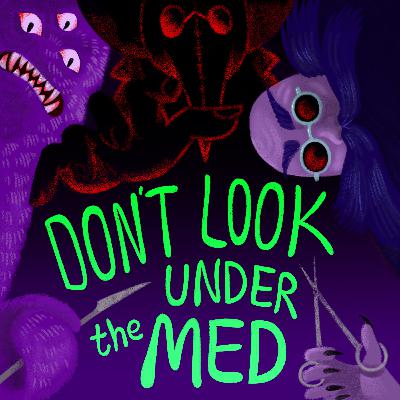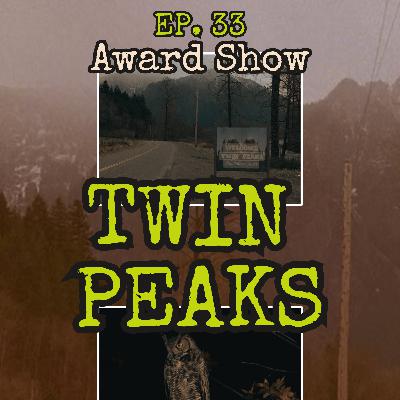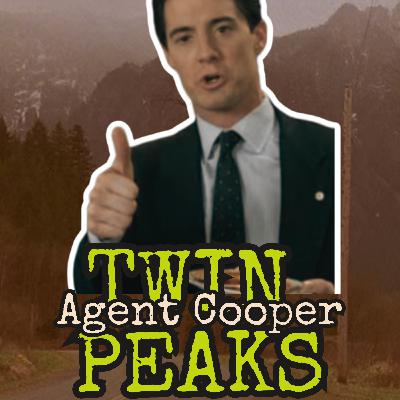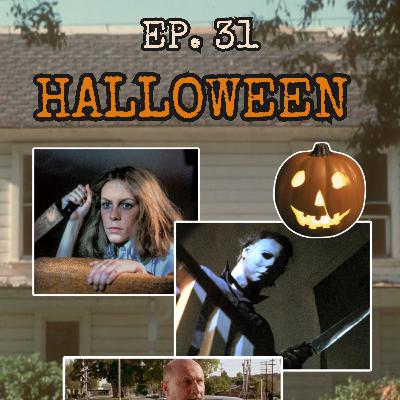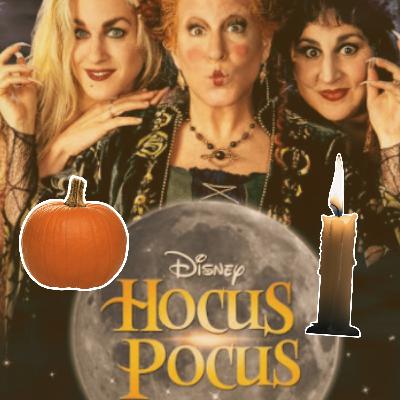Discover Haunted Homebodies: A Cozy Horror Podcast
Haunted Homebodies: A Cozy Horror Podcast

Haunted Homebodies: A Cozy Horror Podcast
Author: Ashley R. Drake and Sara K. Campbell
Subscribed: 20Played: 445Subscribe
Share
© Ashley R. Drake and Sara K. Campbell
Description
If you got it, haunt it. Welcome to Haunted Homebodies, the podcast where two millennial childhood best friends laugh at all of our favorite cozy horror movies and swap some *real* scary stories. If you have ever wished you could join The Midnight Society or can't think of anything cozier than ordering a pizza and watching a scary movie with your friends, then this is the podcast for you. Join us each Thursday as we share all the nostalgic, funny, campy, or otherwise Halloween-coded content we can conjure. Stay Harbinged!
65 Episodes
Reverse
Welcome to the last stop of Season 2! Thank you so much for joining us on this ride.
Today, Ashley and Sara will be discussing Nellie Bly, an American journalist who went undercover to one of New York’s most notorious mental health asylums, the Women’s Lunatic Asylum on Blackwell’s Island, in 1887. The subsequent expose of her 10-day ordeal, called “Ten Days in a Mad-House” provided a first-hand account of the deplorable conditions and treatment of patient’s at the asylum leading to important healthcare changes.
If you are enjoying Don’t Look Under the Med, please help us out and leave a five-star review! And make sure you follow the podcast on your favorite platform so you never miss an episode.
Books:
Bly, N. (2017). Ten Days in a mad-house: Illustrated and annotated: A first-hand account of life at Bellevue Hospital on Blackwell’s Island in 1887. CreateSpace Independent Publishing Platform.
Articles:
National Women’s History Museum- Nellie Bly, by Arlisha R. Norwood
The Biography.com website- Nellie Bly - Story, Timeline & Facts, by Biography.com Editors
Podcast Art By: Irit Mogilevsky
Happy New Year! Thank you for being a part of our journey this year. We are looking forward to sharing more medical misadventures with you in 2024.
Today Sara and Ashley discuss the deadliest fire in Boston’s history and how its aftermath influenced the way hospitals treat burn victims and respond to mass casualties.
If you are enjoying Don’t Look Under the Med, please help us out and leave a five-star review! And make sure you follow the podcast on your favorite platform so you never miss an episode.
Books:
Pletcher, L. (2017). Massachusetts Disasters: True Stories of Tragedy and Survival. Globe Pequot.
Articles:
Bench Press- How the Cocoanut Grove Fire Changed Burn Care at Mass General and Beyond, by Andrew Glyman
Academic Articles:
Saffle JR. The 1942 fire at Boston's Cocoanut Grove nightclub. Am J Surg. 1993 Dec;166(6):581-91. doi: 10.1016/s0002-9610(05)80661-0. PMID: 8273835.
Podcast Art By: Irit Mogilevsky
Welcome to the conclusion of our discussion of Dr. Harry Bailey and his controversial practice of deep sleep therapy.
If you are enjoying Don’t Look Under the Med, please help us out and leave a five-star review! And make sure you follow the podcast on your favorite platform so you never miss an episode.
Books:
Ramsland, K.M. (2007). Inside the Minds of Healthcare Serial Killers: Why They Kill. Praeger Publishers.
Articles:
Australian Dictionary of Biography: Harry Richard Bailey, by Stephen Garton
Wikipedia: Sodium Bromide
Mayo Clinic: Drugs and Supplements: Barbiturate
WebMD: Barbiturate Misuse, by WebMD Editorial Contributors
Scientific American: What Is A Medically Induced Coma and Why Is It Used?, by David Biello
Mad In America: Deep Sleep “Therapy” in Australia in 1960s & ‘70s: Could Something Like This Happen Today?, by Phillip Hickey, Ph.D., August 27, 2020
Youtube Videos:
John Edginton Documentaries: Deep Sleep: Killer Doctor’s ‘Experimental’ Treatment
Podcast Art By: Irit Mogilevsky
Dr. Harry Bailey was once a prominent name in the psychiatric community, but his reputation now is far from respected. This is due to his practice of Deep Sleep Therapy in the 1960s and ’70s at Chelmsford Hospital. This controversial treatment involved administering patients with medication to heavily sedate them, at times to the point of a comatose state. The treatment was frequently used to treat psychiatric conditions like depression, but patients were referred to Dr. Bailey to undergo this “therapy” for anything from obesity to headaches. Unfortunately, the treatment led to the death of several individuals under Dr. Bailey’s care.
If you are enjoying Don’t Look Under the Med, please help us out and leave a five-star review! And make sure you follow the podcast on your favorite platform so you never miss an episode.
Books:
Ramsland, K.M. (2007). Inside the Minds of Healthcare Serial Killers: Why They Kill. Praeger Publishers.
Articles:
Australian Dictionary of Biography: Harry Richard Bailey, by Stephen Garton
Wikipedia: Sodium Bromide
Mayo Clinic: Drugs and Supplements: Barbiturate
WebMD: Barbiturate Misuse, by WebMD Editorial Contributors
Mad In America: Deep Sleep “Therapy” in Australia in 1960s & ‘70s: Could Something Like This Happen Today?, by Phillip Hickey, Ph.D., August 27, 2020
Youtube Videos:
John Edginton Documentaries: Deep Sleep: Killer Doctor’s ‘Experimental’ Treatment
Podcast Art By: Irit Mogilevsky
Join Ashley and Sara for today’s episode in which they discuss the dark history of Metropolitan State Hospital and learn how it earned the ominous nickname “The Hospital of Seven Teeth.”
If you are enjoying Don’t Look Under the Med, please help us out and leave a five-star review! And make sure you follow the podcast on your favorite platform so you never miss an episode.
Books:
Rebello, Tammy & L.F. Blanchard (2016). Abandoned Asylums of Massachusetts. Arcadia Publishing.
Articles:
The Burlington Free Press: Dismembered Body Found at State Hospital, 1980
Boston Globe: Body Found in 3 Graves, A Patient Arraigned, 1980
World Abandoned: Metropolitan State Hospital
Atlas Obscura: Metropolitan State Hospital
Go Xplr: Metropolitan State Hospital
Opacity: Metropolitan State Hospital
Podcast Art By: Irit Mogilevsky
While the hospital is a place of science and medicine, this does not keep our human tendency to be superstitious at bay. In today’s episode we will be exploring a few of the most common hospital superstitions, their origins, and if there is any scientific evidence to support them.
If you are enjoying Don’t Look Under the Med, please help us out and leave a five-star review! And make sure you follow the podcast on your favorite platform so you never miss an episode.
Articles:
ABC: Friday the 13th and Emergency Departments, by Oliva Willis for Sum of All Parts
Fusion Medical Staffing: Top 5 ER Superstitions, by Megan Bebout
Healthline: How Does a Full Moon Affect Our Physical and Mental Well-Being?, by Rebecca Joy Stanborough, MFA
The Washington Post: Friday the 13th: Things You Should Know, by Valerie Strauss
CNN: Why is Friday the 13th Unlucky? The Cultural Origins of An Enduring Superstition, by Christobel Hastings
Academic Articles:
Wu YW, Lai WS, Chen YC. [Superstitious Beliefs Among Healthcare Providers: A Concept Analysis]. Hu Li Za Zhi. 2023 Jun;70(3):85-93. Chinese. doi: 10.6224/JN.202306_70(3).11. PMID: 37259654.
Johnson G. The Q**** Study – basic randomised evaluation of attendance at a children's emergency department. Emergency Medicine Journal 2010;27:A11.
Zargar M, Khaji A, Kaviani A, Karbakhsh M, Yunesian M, Abdollahi M. The full moon and admission to emergency rooms. Indian J Med Sci. 2004 May;58(5):191-5. PMID: 15166467.
Lo BM, Visintainer CM, Best HA, Beydoun HA. Answering the myth: use of emergency services on Friday the 13th. Am J Emerg Med. 2012 Jul;30(6):886-9. doi: 10.1016/j.ajem.2011.06.008. Epub 2011 Aug 19. PMID: 21855260.Podcast Art By: Irit Mogilevsky
We are back today with two more haunted hospital locations!
In this series we share ghostly tales and eerie happenings in the world’s creepiest hospitals, asylums, and other medical establishments. While this episode may be lighter on our usual cold, hard facts, you know we can’t resist sharing a bit of history along the way!
If you are enjoying Don’t Look Under the Med, please help us out and leave a five-star review! And make sure you follow the podcast on your favorite platform so you never miss an episode.
Articles:
US Ghost Adventures - Royal Hope Hospital
Film School Rejects - Digging up the Problem of the Indian Burial Ground Trope
Trolley Tours - Spanish Military Hospital Museum
US Ghost Adventures - Old Tooele Hospital
TV Episodes:
Travel Channel - Ghost Adventures, Tooele Hospital - S18, Ep5 - Aired: 05/27/2011
Travel Channel - Ghost Adventures, Asylum 49 - S18, Ep5 - Aired: 07/15/2017
Podcast Art By: Irit Mogilevsky
It’s that time of year, y’all! To kick off October, our favorite month of the year, Ashley and Sara will be launching a new series called Haunted Hospitals. In this series we will share ghostly tales and eerie happenings in the world’s creepiest hospitals, asylums, and other medical establishments. While this episode may be lighter on our usual cold, hard facts, you know we can’t resist sharing a bit of history along the way!
If you are enjoying Don’t Look Under the Med, please help us out and leave a five-star review! And make sure you follow the podcast on your favorite platform so you never miss an episode.
Articles:
Rolling Hills Asylum - History
Step Out Buffalo - Rolling Hills Asylum
Weird NJ - The Haunting of Rolling Hils Asylum
US Ghost Adventures - St. Ignatius Hospital
Moscow-Pullman Daily News - Perfect space for ‘too many ideas’
The Spokesman Review - St. Ignatius in Colfax finding new life as a haunted hospital
Spokane Historical - St. Ignatius Hospital
TV Episodes:
Travel Channel - Ghost Adventures, Rolling Hills Asylum - S4, Ep2 - Aired: 09/24/2010
YouTube - Ghost Files - The Nightmare Nuns of St. Ignatius - S1, Ep3 - Aired: 10/07/2022
TLC - Paranormal Lockdown - St. Ignatius Hospital - S2, Ep4 - Aired: 01/06/2017
Travel Channel - Ghost Adventures - St. Ignatius Hospital - S21, Ep18 - Aired: 06/15/2019
Podcast Art By: Irit Mogilevsky
Welcome to Part 3, the final installment in our series on Dr. Jack Kevorkian! In today’s episode Ashley and Sara will discuss the systems Dr. Kevorkian utilized to attempt to evade legal repercussions and meet his own moral and ethical standards, the events that led Michigan lawmakers to create a bill outlawing assisted suicide in 1993, and the case that would end it all.
If you are enjoying Don’t Look Under the Med, please help us out and leave a five-star review! And make sure you follow the podcast on your favorite platform so you never miss an episode.
Articles:
The New England Journal of Medicine- Assisted Suicide and Euthanasia in Michigan, by Bachman, Doukas, Lichtenstein, and Alcser
PBS: Frontline- Memorandum Regarding Investigation Into the Death of Hugh Gale, by Carl J. Marlinga, Prosecuting Attorney
Books:
Brovins, Joan M., and Thomas H. Oehmke (1993). Dr. Death: Dr. Jack Kevorkian’s Rx: Death. Lifetime Books.
Podcasts:
Court TV Podcast - Judgement of Dr. Jack Kevorkian
Youtube:
60 Minutes Archives: An Interview with Dr. Jack Kevorkian
CNN: 2010: Kevorkian Admits to Helping Dozens Die
Resources:
If you or someone you know is experiencing suicidal thoughts or a crisis, please reach out immediately to the Suicide & Crisis Lifeline by calling or texting 988. Find out more information here.
Today, in part 2 of our series on Dr. Jack Kevorkian Ashley and Sara will discuss Kevorkian’s early career as a self-proclaimed obitiatrist, or practitioner of physician-assisted death. We will also be discussing Kevorkian’s early legal troubles and his path to becoming one of the most controversial individuals in medical history.
If you are enjoying Don’t Look Under the Med, please help us out and leave a five-star review! And make sure you follow the podcast on your favorite platform so you never miss an episode.
Articles:
CNN- Physician-Assisted Suicide Fast Facts, by CNN Editorial Research Staff
Death With Dignity - Medical Aid in Dying As And End-Of-Life Option Offers Death With Dignity, by Chris Haring
TMZ- Zac Bagans: I Bought Dr. Kevorkian’s DEATH MOBILE
The New York Times - Dr. Jack Kevorkian Dies at 83; A Doctor Who Helped End Lives, by Keith Schneider
The New York Times - Doctor Tells of First Death Using Suicide Machine, by Lisa Belkin
Books:
Brovins, Joan M., and Thomas H. Oehmke (1993). Dr. Death: Dr. Jack Kevorkian’s Rx: Death. Lifetime Books.
Podcasts:
Court TV Podcast - Judgement of Dr. Jack Kevorkian
Other:
Picture of the Thanatron/Mercitron
1992 Michigan Law that banned assisting suicide
Resources:
If you or someone you know is experiencing suicidal thoughts or a crisis, please reach out immediately to the Suicide & Crisis Lifeline by calling or texting 988. Find out more information here.
Between the years of 1990 and 1999, Dr. Jack Kevorkian assisted as many as 130 people to end their lives. Dr. Kevorkian was a staunch supporter of physician-assisted death and was willing to push the ethical, moral, and legal boundaries of medicine in order to fulfill his mission.
Today, in part 1 of our series on Dr. Jack Kevorkian Ashley and Sara will discuss the history of physician-assisted death, ethical considerations and controversy surrounding the Death With Dignity movement in the United States, and Dr. Kevorkian’s early life including the events that led to the development of his “death machine”, the Mercitron.
If you are enjoying Don’t Look Under the Med, please help us out and leave a five-star review! And make sure you follow the podcast on your favorite platform so you never miss an episode!
Articles:
CNN- Physician-Assisted Suicide Fast Facts, by CNN Editorial Research Staff
Death With Dignity - Medical Aid in Dying As And End-Of-Life Option Offers Death With Dignity, by Chris Haring
TMZ- Zac Bagans: I Bought Dr. Kevorkian’s DEATH MOBILE
The New York Times - Dr. Jack Kevorkian Dies at 83; A Doctor Who Helped End Lives, by Keith Schneider
Books:
Brovins, Joan M., and Thomas H. Oehmke (1993). Dr. Death: Dr. Jack Kevorkian’s Rx: Death. Lifetime Books.
Podcasts:
Court TV Podcast - Judgement of Dr. Jack Kevorkian
Picture of the Thanatron/Mercitron
Resources:
If you or someone you know is experiencing suicidal thoughts or a crisis, please reach out immediately to the Suicide & Crisis Lifeline by calling or texting 988. Find out more information here.
Monster Med is back but now with a new name and a new co-host! Make sure to subscribe to Don’t Look Under The Med: Macabre Medical Stories to make sure you never miss a creepy moment.
In today’s episode, Sara and Ashley step into the chilling world of one of America’s first-known female serial killers, “Jolly” Jane Toppan.
Jane Toppan was a relatively well-respected nurse who worked and lived in the Boston area, and between the years of 1880 and 1901 went on a murder spree, poisoning friends, patients, and acquaintances.
From escaping debts to advancing her career, nurse Toppan’s motives to kill were as diverse as they were sinister.
Join us as we piece together Jane Toppan’s early life, her quick turn from what appeared to be a promising nursing career to murder, and the investigation that eventually brought her to justice.
Articles:
Lowell Historical Society - Lowell’s Ties to “Jolly” Jane, Massachusetts’ Female Serial Killer
Radford University: Department of Psychology - Jane Toppan - “Jolly Jane”, researched by Emily Allen, Alana Averill, and Emmeline Cook
Books:
Ciminio, Al (2032). Angels of Death: Murderous Medics, Nefarious Nurses and Killer Carers. Arcturus Holdings Limited.
Ramsland, K.M. (2007). Inside the Minds of Healthcare Serial Killers: Why They Kill. Praeger Publishers.
One last episode before we head off on our holiday break! We are doing things a little differently today by relishing our favorite characters and moments in our very own Twin Peaks award show.Thank you so much for joining us for the first 33 episodes of the coziest podcast in horror-land! We can’t wait to chat with you all again in 2026. Until then, follow us on Instagram to keep tabs on our return. Stay harbinged!Join the Homebodies:Follow us on Instagram and TikTok!Watch Full Video Episodes on YouTube!Credits:Podcast Art: Lunch City StudioMusic: Goosebumps by Veace D
Is there a single more cozy character than Agent Dale Cooper? In today’s episode, we are once again chatting our way through the trippy, cozy, and maybe even a little campy world of Twin Peaks. And the focus of today’s episode is Agent Cooper in all his glory, and also in the few moments that begrudgingly make us realize that he is a mere mortal just like the rest of us. Grab some donuts and a damn fine cup of coffee and cozy up with us for this Coop-filled chat.Join the Homebodies:Follow us on Instagram and TikTok!Watch Full Video Episodes on YouTube!Credits:Podcast Art: Lunch City StudioMusic: Goosebumps by Veace D
Happy Halloween, homebodies! The best day of the year is finally here, and although this month has been chaotic for both of us over here at Haunted Homebodies, we are happy to be drinking in all the October vibes we can get. Today, we are chatting about an absolute October staple and movie that needs no introduction: John Carpenter’s 1978 classic, Halloween. We hope you have the BEST Halloween! Say harbinged, ya’ll. Resources for Today’s Episode:The Movies That Made Us: HalloweenJoin the Homebodies:Follow us on Instagram and TikTok!Watch Full Video Episodes on YouTube!Credits:Podcast Art: Lunch City Studio
Is there anything that gives more nostalgic Halloween vibes than Goosebumps? Today, Sara and Ashley chat about the first episode of Goosebumps that aired on October 27, 1995– The Haunted Mask. Is existential horror the scariest of all? We will have to leave that one to Carly Beth.Join the Homebodies:Follow us on Instagram and TikTok!Watch Full Video Episodes on YouTube!Credits:Podcast Art: Lunch City StudioMusic: Goosebumps by Veace D
Welcome to our inaugural Haunted Homebodies Halloween Special! What better way to get into the spirit of the season than to talk about spirits with your best ghouls? Join us as we reminisce about Halloween’s gone by, discuss our dream Halloween celebrations, and share a few of Ashley’s own haunted tales.Join the Homebodies:Follow us on Instagram and TikTok!Watch Full Video Episodes on YouTube!Credits:Podcast Art: Lunch City StudioMusic: Goosebumps by Veace D
Is there anything that gives more nostalgic Halloween vibes than Goosebumps? Today, Sara and Ashley chat about the first episode of Goosebumps that aired on October 27, 1995– The Haunted Mask. Is existential horror the scariest of all? We will have to leave that one to Carly Beth.Join the Homebodies:Follow us on Instagram and TikTok!Watch Full Video Episodes on YouTube!Credits:Podcast Art: Lunch City StudioMusic: Goosebumps by Veace D
Welcome to our inaugural Haunted Homebodies Halloween Special! What better way to get into the spirit of the season than to talk about spirits with your best ghouls? Join us as we reminisce about Halloween’s gone by, discuss our dream Halloween celebrations, and share a few of Ashley’s own haunted tales.Join the Homebodies:Follow us on Instagram and TikTok!Watch Full Video Episodes on YouTube!Credits:Podcast Art: Lunch City StudioMusic: Goosebumps by Veace D
Oh look, another glorious podcast episode. It makes me sick! This week, Ashley and Sara talk what makes this such an absolute Halloween classic (spoiler alert - the cast), and how they’re both, at heart, Mary’s. It’s all just a bunch of. . .Hocus Pocus. Links for Today’s Episode:Screen Rant: Hocus Pocus Was An Infamous Bomb For Disney: 7 Reasons The Halloween Classic FailedPeople: Which Hocus Pocus Character Are You Based on Your Zodiac Sign?Join the Homebodies:Follow us on Instagram and TikTok!Watch Full Video Episodes on YouTube!Credits:Podcast Art: Lunch City StudioMusic: Goosebumps by Veace D


